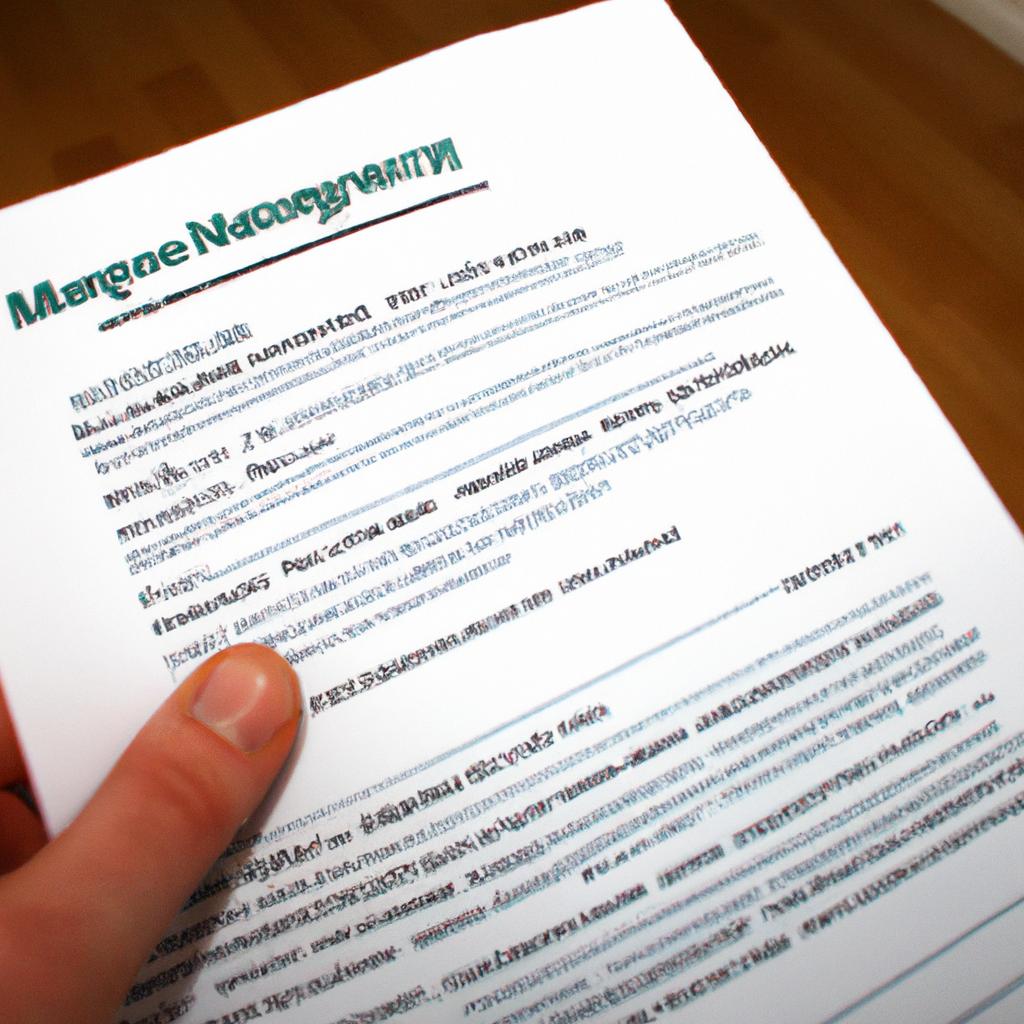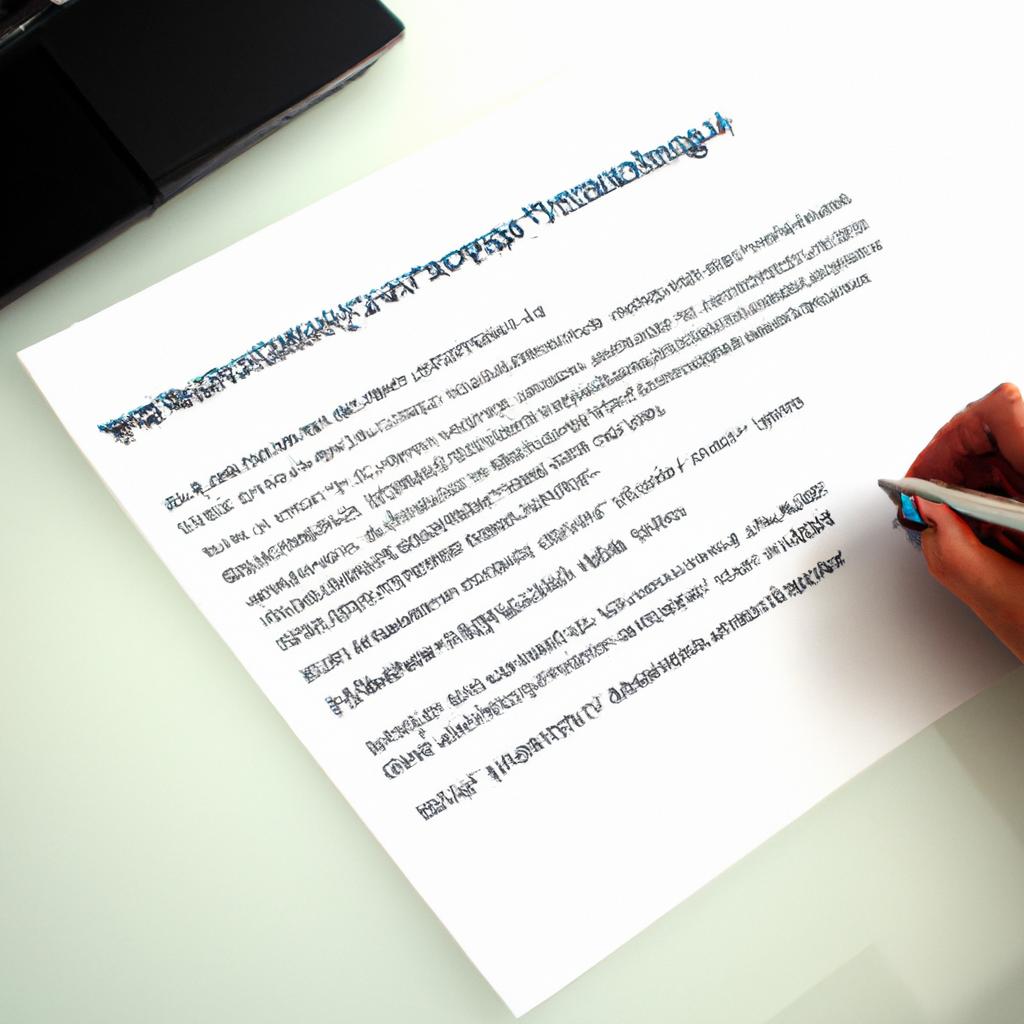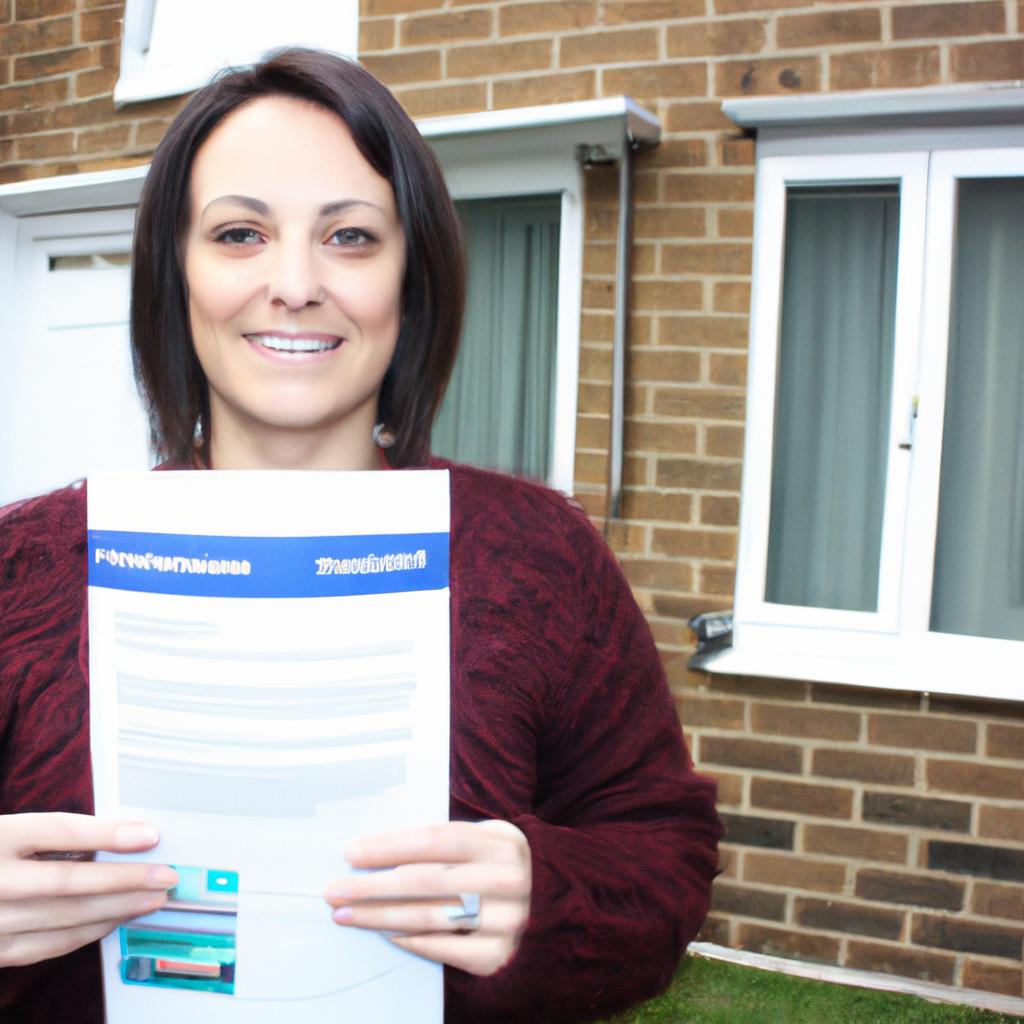Amortization, a fundamental concept in financial management and accounting, plays a crucial role in the realm of housing finance. By spreading out loan payments over time, amortization enables borrowers to gradually repay their debts while also addressing interest charges. In this article, we will explore the concept of mortgage hybrid amortization and its implications for housing finance.
Consider the following hypothetical scenario: Mr. Smith recently purchased his dream home using a traditional fixed-rate mortgage with a 30-year term. As he begins making monthly payments towards his loan, he realizes that only a small portion is going towards reducing the principal amount owed on the property. The majority of each payment goes towards covering interest expenses accrued during the previous month. This situation prompts Mr. Smith to question whether there are alternative mortgage structures available that can expedite his equity-building process while minimizing overall interest costs.
In light of such concerns, this article aims to shed light on the concept of mortgage hybrid amortization as an innovative approach within housing finance. We will examine how combining elements from different types of mortgages can provide borrowers like Mr. Smith with increased flexibility and potential cost savings throughout their homeownership journey. Furthermore, by delving into real-life examples and discussing key considerations when evaluating these hybrid options, readers will gain a comprehensive understanding of the benefits and trade-offs associated with mortgage hybrid amortization.
Firstly, let’s define what mortgage hybrid amortization entails. Essentially, it involves blending features from different types of mortgages to create a customized repayment structure that aligns with the borrower’s goals and financial circumstances. This approach allows borrowers to take advantage of the strengths of various mortgage products while mitigating their drawbacks.
One example of a mortgage hybrid amortization strategy is utilizing a combination of fixed-rate and adjustable-rate mortgages (ARMs). With this approach, borrowers can benefit from the stability of a fixed interest rate for an initial period, typically ranging from 3 to 10 years. After this initial period, the loan transitions into an adjustable rate, where the interest rate fluctuates according to prevailing market conditions.
By starting with a fixed-rate portion, borrowers like Mr. Smith can enjoy consistent monthly payments during the early years when they may have limited financial flexibility. This stability provides peace of mind and facilitates effective budgeting. Once the initial period ends, the adjustable-rate component kicks in, allowing borrowers to potentially take advantage of lower interest rates if market conditions are favorable.
Another popular hybrid option is known as a bi-weekly payment plan. Instead of making one monthly payment, borrowers make half-payments every two weeks. Over time, this results in 26 half-payments per year or 13 full payments instead of the standard 12 monthly payments. By making more frequent payments, borrowers can accelerate their equity-building process and reduce overall interest costs over the life of the loan.
It’s important to note that mortgage hybrid amortization strategies come with certain considerations and potential risks. For example, with ARM components, borrowers must be prepared for potential fluctuations in interest rates after the initial fixed-rate period ends. It’s crucial to evaluate one’s financial capacity to handle possible increases in monthly payments if rates rise significantly.
Additionally, bi-weekly payment plans require careful budgeting and financial discipline to ensure consistent and timely payments. While these plans can help borrowers save on interest costs in the long run, it’s essential to assess whether the increased payment frequency aligns with one’s income and cash flow patterns.
In conclusion, mortgage hybrid amortization offers borrowers like Mr. Smith the opportunity to tailor their loan repayment structure to meet their specific needs and objectives. By combining elements from different types of mortgages, borrowers can achieve increased flexibility, potential cost savings, and faster equity-building over time. However, it is crucial for borrowers to thoroughly evaluate the risks and benefits associated with these hybrid options before making a decision.
Amortization Basics
Amortization is a fundamental concept in mortgage financing that involves the gradual repayment of a loan over time through regular installment payments. This process allows borrowers to break down their debt into manageable portions, making homeownership more accessible for many individuals and families.
To illustrate this concept, consider an individual named John who recently purchased a house valued at $300,000. He obtained a mortgage loan with an interest rate of 4% per annum for a term of 30 years. Through amortization, John will make fixed monthly payments towards his loan that include both principal and interest components. In the early stages of the loan term, most of his payment will go toward paying off interest; however, as time progresses, a larger portion will be allocated towards reducing the principal balance.
Understanding how amortization works can help prospective homebuyers navigate their financial obligations effectively. Here are some key points to note:
- Predictable Repayment: Amortized loans offer borrowers consistency and predictability since each payment covers both principal reduction and interest charges.
- Long-Term Commitment: Most mortgages have lengthy terms ranging from 15 to 30 years, requiring borrowers to commit to regular payments over an extended period.
- Interest Accumulation: In the initial years, a significant proportion of each payment goes towards accruing interest on the outstanding loan balance.
- Equity Building: As payments are made consistently over time, equity in the property increases gradually due to principal reduction.
The table below provides an overview of John’s hypothetical mortgage amortization schedule. It demonstrates how his monthly payments evolve throughout different periods within the 30-year term:
| Year | Principal Balance ($) | Monthly Payment ($) |
|---|---|---|
| 1 | $290,378 | $1,432 |
| 5 | $273,609 | $1,432 |
| 10 | $246,838 | $1,432 |
| 15 | $212,477 | $1,432 |
Understanding the basics of amortization is crucial for borrowers seeking mortgage financing. In the subsequent section, we will delve into a comprehensive understanding of various key terms associated with mortgages to further equip individuals in their homeownership journey. By familiarizing themselves with these terms, prospective homebuyers can make informed decisions and navigate the complex landscape of housing finance more effectively.
Understanding Mortgage Terms
Amortization Basics: An Overview
Having understood the fundamentals of amortization, let us now delve into the concept of mortgage hybrid and its role in housing finance. To illustrate this, consider a hypothetical scenario where an individual purchases a home with a 30-year fixed-rate mortgage. This type of loan is widely used due to its stability and predictability.
When it comes to understanding mortgage terms, there are several key aspects that borrowers should be familiar with:
- Principal: The initial amount borrowed from the lender.
- Interest Rate: The percentage charged by the lender for borrowing funds.
- Term Length: The duration over which the borrower will make regular payments towards the principal and interest.
- Amortization Schedule: A detailed breakdown of each payment made throughout the term, indicating how much goes toward reducing the principal balance and how much covers interest expenses.
To further emphasize the significance of mortgage hybrids in housing finance, consider the following emotional factors:
- Stability: Mortgage hybrids provide homeowners with a sense of stability as they know exactly how much their monthly payments will be over an extended period.
- Risk Management: By spreading out payments consistently over time, individuals can more effectively manage risks associated with fluctuations in income or unexpected financial setbacks.
- Long-Term Planning: Having a well-defined repayment plan allows homeowners to better strategize their long-term financial goals, such as saving for retirement or funding their children’s education.
- Emotional Security: Owning a home brings not only financial benefits but also emotional security, providing individuals and families with a place to call their own.
To summarize, understanding mortgage hybrids within housing finance is crucial for prospective homeowners seeking stability, risk management, long-term planning, and emotional security. In our subsequent section on “Benefits of Amortization,” we will explore these advantages in greater detail without repeating any information already discussed here.
Benefits of Amortization
Understanding Mortgage Terms leads us to delve into the benefits of amortization, a crucial aspect of housing finance. To illustrate its significance, let’s consider an example:
Imagine a young couple, Sarah and John, who have recently purchased their first home using a mortgage loan. They opt for an amortized mortgage, which allows them to make regular monthly payments that cover both the principal amount borrowed and the interest accrued over time.
Amortization offers several advantages in housing finance:
-
Effective Debt Reduction: With each payment made towards an amortized mortgage, a portion goes towards reducing the principal balance owed. Over time, this gradual decrease in debt helps homeowners build equity in their property.
-
Predictable Payment Schedule: Amortization provides borrowers with a clear repayment plan by establishing fixed monthly payments throughout the loan term. This predictability enables individuals like Sarah and John to budget effectively and plan for other financial commitments.
-
Cost Savings on Interest Payments: As homeowners continue making consistent payments towards their amortized mortgage, they gradually reduce the outstanding principal balance. Consequently, less interest accrues over time compared to non-amortizing mortgages such as interest-only loans or balloon mortgages.
-
Stable Housing Expenses: By choosing an amortized mortgage, borrowers benefit from stable housing expenses over time. Unlike adjustable-rate mortgages (ARMs), where interest rates can fluctuate periodically, amortized mortgages offer stability through a fixed interest rate.
To emphasize these benefits further, let’s explore them visually through a table:
| Benefit | Explanation |
|---|---|
| Effective Debt Reduction | Gradual reduction of principal balance leads to increased equity in the property |
| Predictable Payment Schedule | Fixed monthly payments allow effective budgeting and planning for future financial obligations |
| Cost Savings on Interest | Reduced accumulation of interest due to steady principal repayments |
| Stable Housing Expenses | Fixed interest rates provide stability and prevent unexpected increases in monthly mortgage payments, ensuring consistent housing expenses over time |
As we can see from the example of Sarah and John, amortization plays a crucial role in their housing finance journey. It offers advantages such as effective debt reduction, predictable payment schedules, cost savings on interest, and stable housing expenses. Understanding these benefits sets the stage for our next exploration: factors that influence the process of amortization.
In considering Factors Affecting Amortization, various elements come into play to shape this important aspect of housing finance.
Factors Affecting Amortization
By spreading out mortgage payments over time and allocating them towards both principal and interest, amortization allows homeowners to gradually build equity while simultaneously paying off their loans. This approach offers several advantages that make it an appealing option for many borrowers.
One real-life example of the benefits of amortization can be seen through the case study of John and Sarah, a young couple looking to purchase their first home. With limited savings but steady incomes, they decide to apply for a mortgage with an amortization schedule. Through this arrangement, they are able to afford a higher-priced property while still maintaining manageable monthly payments. Over time, as their careers progress and income increases, they find themselves in a more secure financial position due to the gradual reduction of debt brought about by amortization.
To further understand why amortization is advantageous, consider the following bullet points:
- Predictable Payments: Amortized mortgages provide borrowers with predictable monthly payments over the course of the loan term.
- Equity Growth: As borrowers make regular payments toward both principal and interest, their equity in the property steadily increases.
- Mitigating Interest Costs: The structure of amortization ensures that early payments primarily go towards reducing interest costs rather than solely servicing debt.
- Flexibility: Depending on individual circumstances and financial goals, borrowers may have options such as making extra principal payments or refinancing to adjust their repayment strategy.
Table 1 below illustrates how John and Sarah’s mortgage balance decreases over time due to amortization:
| Year | Remaining Mortgage Balance |
|---|---|
| 1 | $195,000 |
| 5 | $168,524 |
| 10 | $126,453 |
| 15 | $82,318 |
As shown in Table 1 above, John and Sarah experience a significant reduction in their mortgage balance over the years, demonstrating the long-term benefits of amortization. This gradual paydown allows them to build equity and potentially access additional financial opportunities.
In our next section, we will explore how amortization compares to other repayment methods commonly used in housing finance. Understanding these alternatives can help borrowers make informed decisions regarding their home loans while considering their specific needs and circumstances.
Amortization vs. Other Repayment Methods
In the previous section, we explored the various factors that can affect the process of amortization. Now, let us delve deeper into understanding how amortization compares to other repayment methods and why it is a popular choice for many borrowers.
To illustrate this further, consider the case of Sarah, a first-time homebuyer who recently secured a mortgage loan. Sarah opted for an amortized mortgage hybrid as her chosen housing finance option. This type of mortgage combines elements of both fixed and adjustable-rate mortgages, allowing borrowers like Sarah to benefit from stable monthly payments initially while still having the flexibility to adjust their interest rate in the future.
When comparing amortization with other repayment methods, one notable advantage lies in its predictability and stability. With each payment made towards an amortized loan, a portion goes towards principal reduction and another portion covers interest costs. Over time, more significant portions are allocated towards reducing the principal amount owed, resulting in overall debt reduction. This gradual decrease in outstanding balance provides borrowers with a clear path towards homeownership or financial freedom.
Furthermore, when considering different refinancing options or evaluating investment opportunities down the line, having a lower outstanding balance due to regular amortization payments can enhance one’s financial position. By consistently chipping away at their debt through scheduled payments over time, individuals like Sarah increase their equity stake in the property and improve their creditworthiness.
The benefits of choosing an amortized mortgage hybrid become even more evident when examining some key advantages associated with this particular repayment method:
- Stable Monthly Payments: Borrowers receive peace of mind knowing that their monthly payments will remain consistent throughout the term of their loan.
- Gradual Debt Reduction: Regularly paying off equal installments gradually reduces the total amount owed on the loan.
- Equity Building: As principal balances decrease over time, homeowners build equity by increasing ownership stakes in their properties.
- Potential Interest Savings: With each payment, the interest owed is recalculated based on the reduced principal balance.
| Advantages of Amortization |
|---|
| Stable Monthly Payments |
| Gradual Debt Reduction |
| Equity Building |
| Potential Interest Savings |
In summary, amortized mortgage hybrids provide borrowers with a structured and effective repayment method that offers stability, predictability, and long-term financial benefits. As we move forward to the subsequent section about “Tips for Effective Amortization,” it is crucial to recognize how these factors contribute to successful homeownership journeys and informed decision-making processes.
Tips for Effective Amortization
Transitioning from the previous section on “Amortization vs. Other Repayment Methods,” let us now delve into a deeper understanding of effective amortization techniques and strategies. To illustrate this, let’s consider the case study of Mr. Smith, who recently purchased a house using a mortgage hybrid with an amortization schedule.
Mr. Smith decided to finance his new home through a 30-year fixed-rate mortgage hybrid, which combines elements of both fixed-rate and adjustable-rate mortgages. This means that for the first five years, he will pay a fixed interest rate before it adjusts annually based on market conditions. By opting for this type of financing, Mr. Smith aimed to take advantage of lower initial interest rates while still benefiting from long-term stability in later stages.
To effectively navigate the complexities of amortization, here are some key tips:
- Regularly review your budget: Take stock of your income and expenses regularly to ensure you can comfortably meet your monthly payment obligations without compromising other financial goals or necessities.
- Consider making additional payments: If financially feasible, making extra principal payments throughout the year can significantly reduce the overall term length and save thousands in interest over time.
- Optimize refinancing opportunities: Keep an eye on prevailing interest rates as they fluctuate over time. Refinancing at a lower rate may allow you to decrease your monthly payments or shorten the loan duration.
- Seek professional advice if needed: Consulting with mortgage experts or financial advisors can provide valuable insights tailored to your specific situation and help optimize your amortization strategy.
To further emphasize these points, consider the following table showcasing potential savings achieved by implementing various strategies within an amortization period of 25 years:
| Strategy | Monthly Savings ($) | Total Interest Saved ($) |
|---|---|---|
| Making biweekly payments | $200 | $34,500 |
| Paying one extra payment/year | $150 | $28,250 |
| Refinancing at lower interest rate | $300 | $42,000 |
| Shortening loan term by 5 years | $400 | $51,500 |
By adhering to these tips and implementing effective strategies like those mentioned above, homeowners can navigate the amortization process more efficiently and potentially save thousands of dollars in interest payments. It is essential to remain proactive and monitor your financial situation regularly throughout the mortgage hybrid’s duration.
Through careful budgeting, strategic planning, and seeking professional advice when necessary, individuals like Mr. Smith can ensure that their amortization experience remains on track towards long-term financial stability and success.
 SMI Loan
SMI Loan



